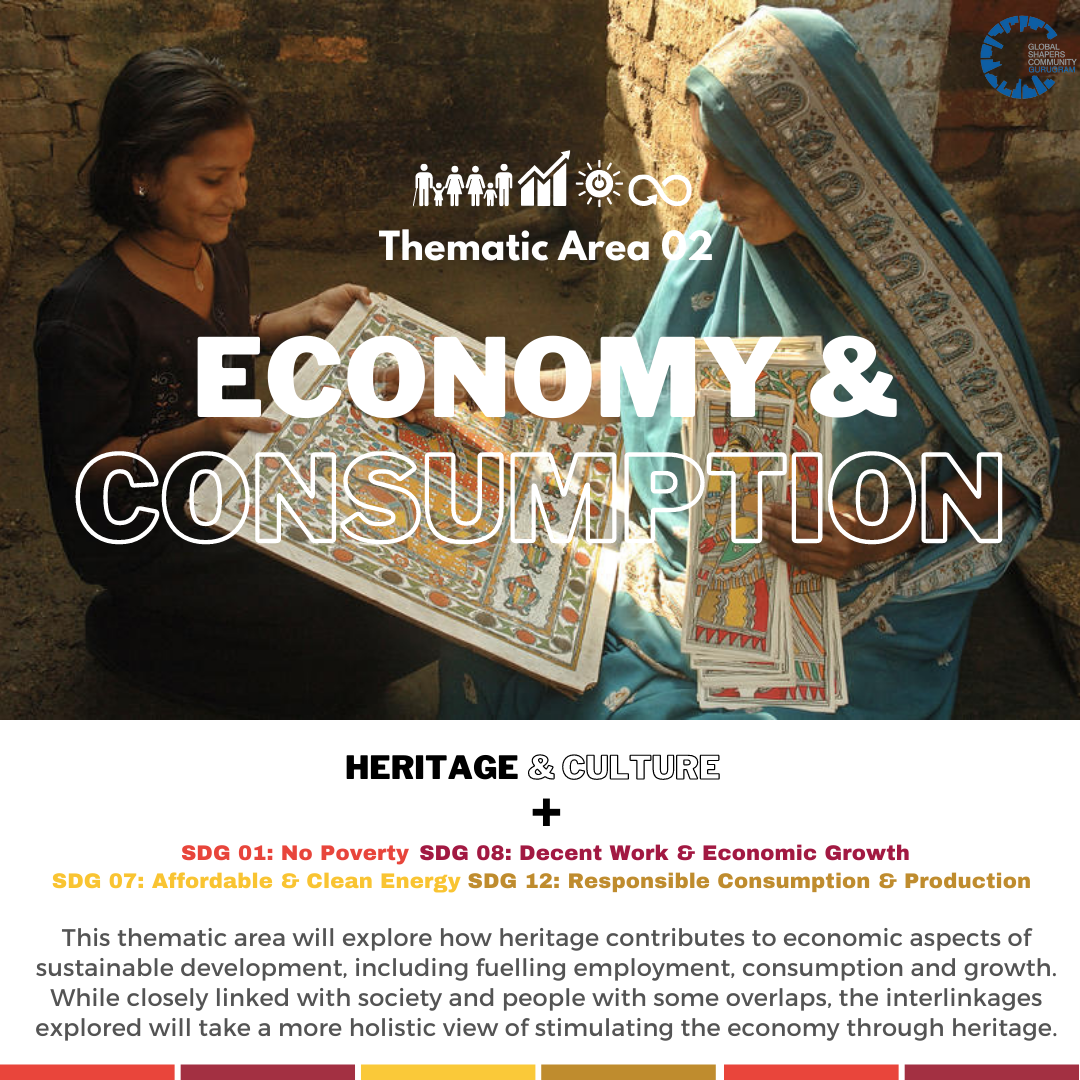
Heritage for Economy and Consumption

There is no denying that heritage, whether built or natural, is a prime driver of tourism, which in turn stirs economic growth and consumption. The goals of Agenda 2030, resting on the crux of “no one left behind”, especially those related to economy and consumption, can be achieved by leveraging the potential of heritage sites for the advancement of local communities and economies to a large extent. This will fuel the growth of the job market/opportunities, increase consumption and lead to the growth of the economy itself.
All heritage sites, and the social, cultural and natural capital they encapsulate, attract creative industries (including and not limited to, artisans, textiles, handicrafts and so on), bringing with them indigenous businesses, inhabitants and most importantly, tourists, who can catalyse economic growth and prosperity in that region. Heritage can, in fact, lead to the inflow of a wide array of activities which support employment and sustain local economies, especially the hospitality and tourism industries, which are the economic drivers of various regions that rely on their cultural, man-made and natural heritage. Beyond tourism and hospitality, heritage can be the source of economic activities related to site management, urban regeneration (which can enhance real estate and land values of the region) and other cultural and educational activities like museums, archaeology, tour guides and even food, retail and crafts which depend on tourists visiting the heritage sites.
Thus, heritage can serve three purposes for the overall advancement of a region – empower the economy, encourage local entrepreneurship, and finally provide livelihoods. Ensuring that this advancement is inclusive, equitable and sustainable to the highest degree, can make heritage a significant factor in driving the economy and accelerating consumption, which is directly related to SDG 8, and indirectly to SDG 1 & 12.
However, the flip side of the argument can be the environmental degradation caused by irresponsible tourism, and waste generation due to excessive consumption. It is the endeavour of every heritage advocate to ensure that tourism driven by heritage does not further aggravate the perturbations in the ecological sensitivity of these regions. Ensuring economic growth and consumption, while preserving the environment and promoting sustainability has perplexed policymakers for decades, and heritage, if governed properly, can provide this intrinsic balance. Very closely connected to this is SDG 12, on Responsible Production and Consumption. This SDG is critical when we consider the extent of the environmental and social damage brought by irresponsible, unsustainable production methods (which can be argued as the main driver of the ecological crisis we see today) and rampant consumerism, which is also a cause of many of the issues related to climate change (waste generation, plastic use, emissions etc.).
Decoupling economic growth from unsustainable natural resource use can save us from the many impending threats which endanger humanity.
When we consider heritage and its impact on responsible production and consumption patterns, the linkages are very apparent if we see how heritage sites capitalize on efficient usage and reusing of natural resources and rely on local materials in their vicinity. Local materials and their usage are important when we consider the high carbon footprint of transporting materials from elsewhere. Another factor to consider is how traditional community practices (often part of the local cultural heritage) are environment-friendly, which ensures that the carrying capacity and regenerative cycles of the natural environment are maintained, and a ‘tragedy of the commons’ is prevented, as the ‘commons’ serve the needs in a just and equitable manner, without overexploitation or over-extraction. Traditional indigenous practices not only make the pursuit of sustainable development more effective but also preserve bio-cultural diversity. Rehabilitation and restoration of heritage sites is another instance of responsible consumption and production, when we consider the reduced need for materials, avoidance of emissions through negating demolition and conserved energy (lower carbon footprints). On one hand, traditional customs conserved by cultural heritage can help mitigate modern wasteful practices, and built heritage on the other becomes significant towards redefining modern construction paradigms and principles.
Consumption and production of services and goods centred around heritage is a double-edged sword- it can guide and correct the prevalent course of action but also contribute to irresponsible consumption.The rising consumption associated with tourism must be avoided in the meaningful pursuit of SDG 8, with innovative approaches to manage the needs of the visitors in balance with those of local, indigenous communities.
References:
- Heritage and the sustainable development goals: policy guidance for heritage and development actors, prepared by Prepared by the Sustainable Development Goals Working Group – Priority Action 1 Task Team, and published by International Council on Monuments and Sites – ICOMOS, Source Link: https://openarchive.icomos.org/id/eprint/2453/
- Culture: at the Heart of SDGs by Jyoti Hosagrahar, published in The UNESCO Courier, Source Link: https://en.unesco.org/courier/april-june-2017/culture-heart-sdgs
- UNESCO’s interactive visual – Living Heritage and Sustainable Development Link – https://ich.unesco.org/dive/sdg/
- Heritage Conservation and the Sustainable Development Goals, Published by International National Trusts Organisation, Source Link: https://www.into.org/app/uploads/2020/11/INTO-members-and-the-SDGs.pdf
- The Culture 2030 Indicators, published in 2019 by the United Nations Educational, Scientific and Cultural Organization, Source Link: https://unesdoc.unesco.org/ark:/48223/pf0000371562
- UNESCO’s interactive visual Living Heritage and Sustainable Development, Source Link: https://ich.unesco.org/dive/sdg/

